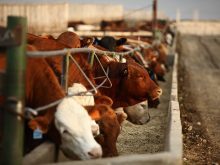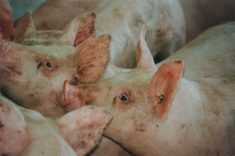They’re adding protective plexiglass shields, bringing in trailers to separate groups of workers, and boosting communication on biosecurity.
It’s all part of an ongoing effort to ensure pork processing plants aren’t disrupted by COVID-19.
“I’m very impressed by our packers, and for the workers for coming to work every day and being there and realizing that they are an essential service,” said Darcy Fitzgerald, executive director of Alberta Pork.
“Our processors have come up with some pretty innovative ways to do things differently and offer greater comfort and safety for their workers. The precautions are there and everyone is mindful of their safety.”
Read Also

China imports no US soybeans for third month; Argentine arrivals up 634 per cent
China imported no soybeans from the United States for a third straight month in November, as buyers turned to South American supplies amid fears of a shortfall if the trade war with Washington dragged on.
But while “things are moving along smoothly right now,” no one is taking anything for granted.
“We’re sitting on pins and needles right now, not wanting anything to go awry,” said Fitzgerald.
There’s an ongoing need for more masks and gloves, and officials in the sector are closely monitoring both the availability and cost of inputs and supplies needed by producers, said Gary Stordy, director of government and corporate affairs with the Canadian Pork Council.
“At this point, there is no indication that it is severely impacting production, but people are paying attention to some of the levels,” he said.
While there is good demand for pork products, the futures market is the worst Fitzgerald has seen in 11 years.
“It’s only because we have this speculation and people who every day trade and make the market go up and down to make money — and we’re playing with food,” he said.
“We’re seeing a lot of demand around the world for the product. It’s not like there is going to be a lack of demand or shortage anytime soon.”
Stay in touch
Both financial and mental health concerns are always lurking under the surface in the hog industry, Stordy said.
“COVID-19 has the potential to do harm to both,” he said. “Producers are incredibly resilient, but as we continue in this pandemic, these factors are becoming more and more of a concern.”
His organization has been telling producers to maintain social distancing, but not socially isolate themselves. Instead, they should stay in touch with their fellow producers.
“We’re in this together — use your colleagues, and talk to your fellow farmers in similar situations, and maintain that level of contact,” said Stordy.
Communication is vital throughout the entire pork value chain, added Fitzgerald.
“We’re a very small community on this planet, and every piece has to work together,” he said. “It if doesn’t, we start to see the real hiccups. This hopefully reminds everyone of that and how we can work better together.”
— Alexis Kienlen reports for Alberta Farmer from Edmonton.















